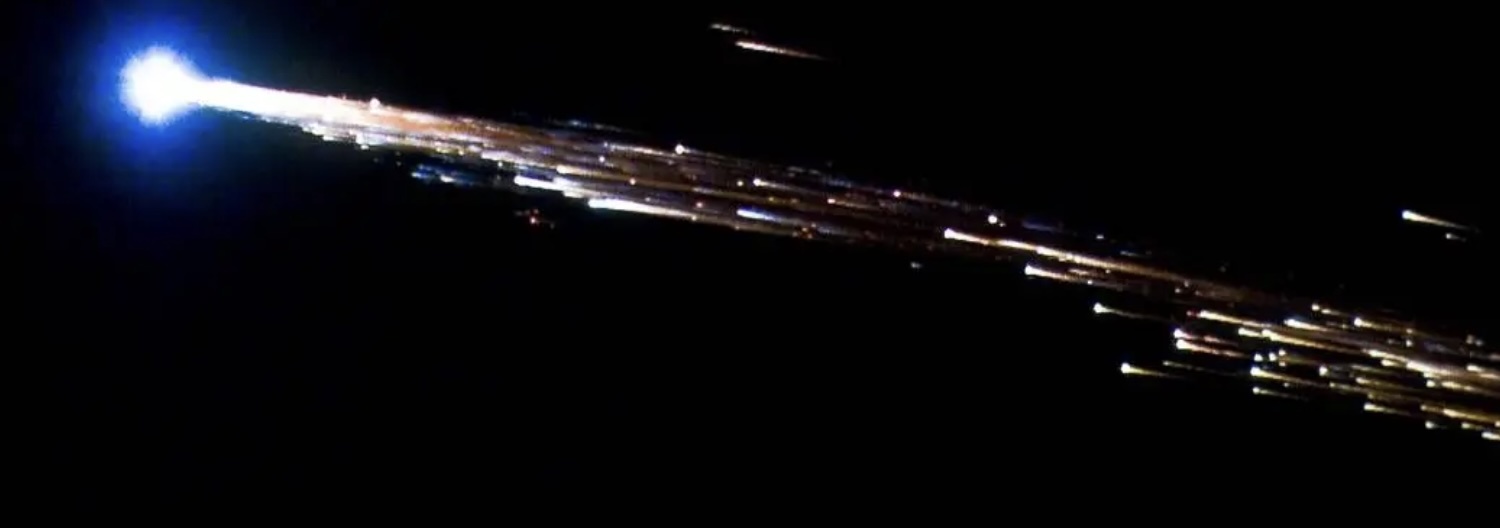1.11.2025

Reentry of the ATV Jules Verne spacecraft showing it breaking apart. Credit - NASA/ESA/Bill Moede and Jesse
Carpenter
We successfully plugged the hole in the ozone layer that was discovered in the 1980s by
banning ozone depleting substances such as chlorofluorocarbons (CFCs). But, it seems we
might be unintentionally creating another potential atmospheric calamity by using the upper
atmosphere to destroy huge constellations of satellites after a very short (i.e. 5 year)
lifetime. According to a new paper by Leonard Schulz of the Technical University of
Braunschweig and his co-authors, material from satellites that burn up in the atmosphere,
especially transition metals, could have unforeseen consequences on atmospheric
chemistry - and we’re now the biggest contributor of some of those elements.
It’s been a long time coming that we would be though - Earth has plenty of other material
spread through its upper atmosphere via meteorites burning up. In fact, even now, according
to the paper, the total mass of material injected into the atmosphere from rockets and
satellites is only about 7% of the mass of meteors that hit Earth annually. However, since the
rockets and satellites are primarily made up of metals, whereas meteors are primarily made
of up silicates, the amount of metal we inject into the atmosphere is around 16% that of
natural causes.
That may not sound like much, but for a few particular elements it's much, much higher. In
2015, anthropogenic (i.e. human-made) sources were the highest contributor to 18 different
elements in the atmosphere. In 2024 that number jumped to 24 different elements. That
could grow to as much as 30 different elements that we will be the primary reason for their
increased levels in the atmosphere in the coming decades.
Even active debris removal, like Fraser discusses here, would result in these elements being
seeded throughout the atmosphere.
Some of those elements are relatively common on the Earth itself - such as lithium and tin -
and they shouldn’t have any major impacts on the atmosphere. However, some are
“transition metals”, which are well known for their catalytic activity. Their increased presence
in the atmosphere could catalyze reactions that could have devastating impacts on
atmospheric chemistry at large. These elements include several that are fundamental to
spacecraft construction such as copper (wirings / PCB traces) and titanium (structural
supports).
By the paper’s calculations, the injections of those elements have more than doubled in the
last 10 years, primarily due to the advent of satellite mega-constellations like Starlink and
Kuiper. Satellites in these constellations are intentionally designed to “demise” themselves
after a few years by burning up in the atmosphere. While this might solve the problem of a
bunch of derelict junk that could potentially turn into hazardous projectiles (via Kessler
syndrome), it creates its own problem of potentially messing up the atmosphere’s chemistry.
Dr. Schulz and his co-authors estimate that there are three different ways this “space
waste”, as they call it, can affect the environment. First is by directly acting as a catalyst for
reactions that destroy the ozone - much as CFCs did back in the 70s and 80s. Next would
be to act as “seeds” for cloud formation, potentially altering how clouds form in certain parts
of the atmosphere, which in turn can dramatically impact weather patterns lower down. A
third risk would be the radiative effects of particles in the atmosphere. They could either
reflect or trap heat from the Sun, cooling or warming the atmosphere in difficult-to-discern
ways. In fact, a version of this is one geoengineering challenge that is put forward as a
potential solution to climate change.
Fraser discusses different options for dealing with space junk - almost all of them could
exacerbate the transition metals problem.
But the fact is that we don’t understand well enough what impact these elements will have
on the atmosphere yet. No one has studied how titanium may catalyze ozone depletion, or
whether lithium would reflect sunlight when left to float in the stratosphere. As the authors
of the paper point out - we absolutely need to understand these impacts if we are planning
to use satellite mega-constellations in the long-term, especially if the life-span of their
individual components is only five years. Whether or not researchers will receive funding for
that effort remains to be seen, but, since we’ve already seen it happen with other chemicals,
maybe it's a good idea for us to get ahead of the problem this time.
Quelle: Universe Today
